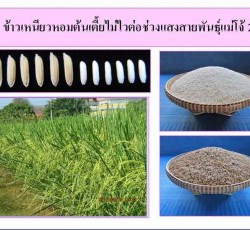ชื่อเรื่อง(ไทย)
การปรับปรุงพันธุ์ข้าวเหนียวหอมจากข้าวเจ้าด้วยวิธีผสมกลับโดยใช้เครื่องหมายโมเลกุลช่วยในการคัดเลือกชื่อเรื่อง(Eng)
IMPROVEMENT OF AROMATIC GLUTINOUS RICE FROM NON-GLUTINOUS RICE BY USING MARKER-ASSISTED BACKCROSSINGชื่อผู้วิจัย(ไทย)
วราภรณ์ แสงทอง ประวิตร พุทธานนท์ และสุภักตร์ ปัญญาชื่อผู้วิจัย(Eng)
VARAPORN SANGTONG, PRAWIT PUDDHANON AND SUPAK PHANYAหน่วยงาน
สาขาวิชาพันธุศาสตร์ คณะวิทยาศาสตร์ ,สาขาวิชาพืชไร่ คณะผลิตกรรมการเกษตรบทคัดย่อ
ประเทศไทยมีพื้นที่ปลูกข้าวทั้งหมด 57 ล้านไร่ เป็นพื้นที่ปลูกข้าวเหนียว 18 ล้านไร่ ซึ่งคิดเป็น 31% ของพื้นที่ ที่ปลูกข้าวทั้งหมด. พันธุ์ข้าวเหนียวไม่ไวต่อช่วงแสงต้นเตี้ยที่ชาวนานิยมปลูกมีเพียง 3 พันธุ์ ได้แก่ ข้าวเหนียวพันธุ์สันป่าตอง 1 กข 10 และแพร่ 1 ในขณะที่ข้าวเจ้าพันธุ์ดีมีมากมาย. ดังนั้นโครงการนี้มีวัตถุประสงค์เพื่อนำข้าวเจ้าพันธุ์จำนวน 2 พันธุ์ คือ ข้าวเจ้าพันธุ์ชัยนาท 80 และสุพรรณบุรี 1 ซึ่งมีผลผลิตสูง ต้นเตี้ย ไม่ไวต่อช่วงแสง ตานทานต่อโรคและแมลงที่สำคัญของข้าวมาเป็นพันธุ์รับ เพื่อปรับปรุงพันธุ์ให้เป็นข้าวเหนียวหอมด้วยวิธีผสมกลับโดยใช้เครื่องหมายโมเลกุลช่วยในการคัดเลือก ซึ่งเป็นการคัดเลือกในระดับยีโนไทป์หรือยีน ทำให้การคัดเลือกมีความถูกต้อง แม่นยา และช่วยลดระยะเวลาในการปรับปรุงพันธุ์ให้สั้นลง การทดลองเริ่มจากในฤดูแรกผลิตเมล็ด F1 โดยผสมข้าวเจ้าพันธุ์สุพรรณบุรี 1 และชัยนาท 80 ซึ่งใช้เป็นพันธุ์รับ กับข้าวเหนียวพันธุ์ กข 6 ซึ่งใช้เป็นพันธุ์รับ ผลการทดลองพบว่า ผลิตเมล็ด F1 ของคู่ผสมระหว่างชัยนาท 80 กับ กข6 ได้จำนวน 19 เมล็ด ส่วนคู่ผสมระหว่างสุพรรณบุรี 1 กับ กข6 ได้จำนวน 82 เมล็ด ในฤดูที่ 2 ผลิตเมล็ด BC1F1 ของคู่ผสมข้าวเจ้าชัยนาท 80 กับข้าวเหนียวพันธุ์ กข6 ได้จำนวน 57 เมล็ด และผลิตเมล็ด BC1F1 ของคู่ผสมข้าวเจ้าพันธุ์สุพรรณบุรี 1 กับข้าวเหนียวพันธุ์ กข6 ได้จำนวน 147 เมล็ด นอกจากนี้พบว่า background markers จำนวน 8 ตำแหน่ง ที่สามารถแยกความแตกตางทางพันธุกรรมระหว่างข้าวเจ้าพันธุ์ชัยนาท 80 กับข้าวเหนียวพันธุ์ กข6 ได้ และ background markers จำนวน 7 ตำแหน่ง ที่สามารถแสดงความแตกตางทางพันธุกรรมระหว่างข้าวเจ้าพันธุ์สุพรรณบุรี 1 กับข้าวเหนียวพันธุ์ กข6 ได้
คำสำคัญ: ข้าวเหนียว ข้าวเจ้า ผสมกลับ และเครื่องหมายโมเลกุล
Abstract
Thailand has about 57 million rais of land grown to rice, 18 million of which have been planted to glutinous rice, comprising about 31% of the total area. There have only been about 3 rice varieties which farmers preferred to cultivate: Sanpatong 1, RD6 and Phrae 1 among the many good varieties of non-glutinous rice varieties, This project aimed to use two good glutinous rice varieties (Chainat 80 and Suphanburi 1) which are high yielding, dwarf, non-photoperiod sensitive and high resistance to disease and pests which are considered important characteristics of the rice plant as receiver plant in order to improve the rice varieties to become sweet glutinous by molecular marker-assisted backcrossing to select genotypes or genes that would lead to proper selection of recurrent parents and at the same time, reduce the time period of improvement. The experiment was started initially with the production of F1 seeds by crossing Suphanburi 1 and Chainat 80 which were used as donor parents with glutinous RD6 as recurrent parents. Results showed that 19 F1 seeds were produced by the cross between Chainat 80 and RD 6 while 82 seeds resulted from the cross between Suphanburi 1 and RD6. In the second planting season, 57 BC1F1 seeds resulted from the cross between non-glutinous Chainat 80 and glutinous RD6 while 147 seeds were produced from the cross between non-glutinous Suphanburi 1 and glutinous RD6. Aside from these, results also showed that 8 background markers were located in loci positions which could separate the genetic differences between non-glutinous Chainat 80 and glutinous RD6 and 7 background markers which were able to show the genetic difference between non-glutinous Suphanburi 1 and RD6.
Keywords: glutinous rice, non-glutinous rice and molecular markers

